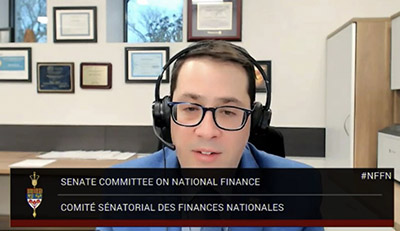
College of Dentistry would welcome federal help to boost child dental care
Canadian dental colleges well-positioned to play a role in supporting dental benefit proposal, says Dentistry dean
The dean of the University of Saskatchewan College of Dentistry says Canadian dental colleges have a role to play in expanding child oral health care as part of the federal government's proposed Canada Dental Benefit.
Dean Walter Siqueira told Parliament's Standing Senate Committee on National Finance that Canada's 10 dental colleges are already committed to important oral health training and research, but they would be able to do more with federal government support.
 “Canadian dental schools are ready to be engaged in this critical initiative,” Siqueira told federal senators during testimony Nov. 1. “The dentistry schools are ready with the resources, infrastructure and expertise to support the new program. Our (USask) dentistry school could expand the training and service delivered with this new program.”
“Canadian dental schools are ready to be engaged in this critical initiative,” Siqueira told federal senators during testimony Nov. 1. “The dentistry schools are ready with the resources, infrastructure and expertise to support the new program. Our (USask) dentistry school could expand the training and service delivered with this new program.”
The USask Dental Education Clinic has more than 15,000 patient visits per year, while across Canada, dental colleges receive an estimated 370,000 patient visits annually. With 1,500 dental chairs available in the 10 colleges, there is capacity to double the number of patient visits with government funding support. The USask clinic charges a flat fee of $20 for visits by children and offers significantly reduced fees for adult procedures. The situation is similar at other colleges, Siqueira said.
The proposed Canada Dental Benefit would provide up-front, tax-free payments to cover dental expenses for children under 12 years of age to families with a combined annual income less than $90,000. Payments would range from $650 per child annually for families with income less than $70,000, to $260 per child for families with an income between $80,000 and $89,999.
The federal government estimates 500,000 Canadian children will benefit from the initiative at a cost of $938 million, according to a government background document. It is designed as an interim measure while the government develops a long-term program.
Dental colleges strongly support the initiative. Earlier this year, the Association of Canadian Faculties of Dentistry sent a letter to the federal health minister saying schools are engaged and willing to participate in order to maximize the use of resources and the quality of life for Canadians.
Expertise available through the colleges would benefit the program’s operation, ensure the best return for investment, and provide excellent care for children, Siqueira said. While providing a direct dental benefit is a positive step to support families, he is concerned it may have a limited effect when it comes to improving the overall oral health of Canadian children.
“We have the best experts in the country in the area of population health, in dental public health,” he said. “What we would like is to have the government engage the dentistry schools and involve the oral health researchers in this initiative. We deal with the two most (common) chronic diseases in Canada – tooth decay and gum disease. We need to invest in prevention, not just the therapeutic (care).”
Siqueira said he sees the bill as a good start in addressing the lack of universal dental care.
When members of the Senate committee asked about the cost of dental treatment for children, Siqueira said there is no “typical” amount. However, experience shows patients often arrive at clinics with several oral health issues.
“It is a very difficult question — What is the typical amount of dental care for a child? — because it depends on the treatment,” he explained. “I can say that $260 or $650 is not enough to provide comprehensive dental care in a child, specifically with clientele that come to the dentistry schools who don’t come with just one cavity, but with three or four or five and other oral health care problems that need to be solved.”
Dental treatment is not part of Canada’s public health-care system, which means patients must either pay directly or through workplace benefits. But for families without benefits, the cost of dental care can be a barrier.
According to Siqueira, dental colleges see participation in the proposed federal program as a way to offer cost-effective service to children and families while also supporting training of the next generation of oral health professionals.
Dental colleges already offer significant service and care to underserved communities. The USask College of Dentistry, for instance, operates community-based clinics in Saskatoon and several northern and Indigenous communities. A dental therapy program that will launch in fall 2023 at sites in La Ronge, Prince Albert and Regina is focused on training Indigenous students to provide care in their home communities.
Siqueira believes federal government support of dental colleges as part of the initial child dental benefit — and any future, long-term dental care program — would strengthen the training and research provided by colleges. It would also improve access to care for children, individuals with special needs, and the elderly, particularly those in underserved communities.
“We have the leadership, and we have the experts in the country that can provide the support,” he told Senate committee members. “What we need as dentistry schools to support this important initiative . . . is funds to pay for free dental care in the dentistry schools and the dentistry school community clinics. We need to discuss the expansion of personnel, professors and staff, and also expansion of our training.”

